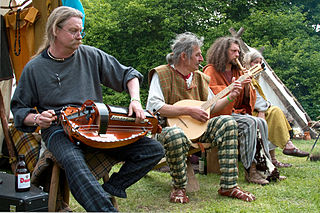 W
WThe Celtic Revival was a variety of movements and trends in the 19th and 20th centuries that saw a renewed interest in aspects of Celtic culture. Artists and writers drew on the traditions of Gaelic literature, Welsh-language literature, and so-called 'Celtic art'—what historians call Insular art. Although the revival was complex and multifaceted, occurring across many fields and in various countries in Northwest Europe, its best known incarnation is probably the Irish Literary Revival. Irish writers including William Butler Yeats, Lady Gregory, "AE" Russell, Edward Martyn, Alice Milligan. and Edward Plunkett stimulated a new appreciation of traditional Irish literature and Irish poetry in the late 19th and early 20th century.
 W
WThe modern Celts are a related group of ethnicities who share similar Celtic languages, cultures and artistic histories, and who live in or descend from one of the regions on the western extremities of Europe populated by the Celts.
 W
WGeorge Bain (1881–1968), born in Scrabster in Caithness, Scotland, was an artist and art teacher who made an important and influential contribution to the revival of interest in Celtic and Insular art which began in the 19th century
 W
WCeltic Family Magazine was a Los Angeles, California-based print and electronic publication, serving Celtic communities and their descendants around the world. Celtic Family Magazine published special features and articles on art, history, culture, entertainment, and lifestyle. Celtic Family Magazine was produced by A Raven Above Press and was distributed throughout North America and select areas of the United Kingdom.
 W
WThe Celtic Media Festival, formerly known as the Celtic Film and Television Festival, aims to promote the languages and cultures of the Celtic nations in film, on television, radio and new media. The festival is an annual three-day celebration of broadcasting and film from Scotland, Ireland, Wales, Isle of Man, Galicia, Cornwall and Brittany. The festival was founded in 1980.
 W
WThe Gaelic revival was the late-nineteenth-century national revival of interest in the Irish language and Irish Gaelic culture. Irish had diminished as a spoken tongue, remaining the main daily language only in isolated rural areas, with English having become the dominant language in the majority of Ireland.
 W
WGorsedh Kernow is a non-political Cornish organisation, based in Cornwall, United Kingdom, which exists to maintain the national Celtic spirit of Cornwall. It is based on the Welsh-based Gorsedd, which was founded by Iolo Morganwg in 1792.
 W
WCeltic festivals celebrate Celtic culture, which in modern times may be via dance, Celtic music, food, Celtic art, or other mediums. Ancient Celtic festivals included religious and seasonal events such as bonfires, harvest festivals, storytelling and music festivals, and dance festivals. This list includes Celtic festivals held throughout the world.
 W
WPan-Celticism, also known as Celticism or Celtic nationalism is a political, social and cultural movement advocating solidarity and cooperation between Celtic nations and the modern Celts in North-Western Europe. Some pan-Celtic organisations advocate the Celtic nations seceding from the United Kingdom and France and forming their own separate federal state together, while others simply advocate very close cooperation between independent sovereign Celtic nations, in the form of Irish nationalism, Scottish nationalism, Welsh nationalism, Breton nationalism, Cornish nationalism and Manx nationalism.
 W
WThe Tailteann Games or Aonach Tailteann was an Irish sporting and cultural festival held in the Irish Free State in 1924, 1928, and 1932. It was intended as a modern revival of the Tailteann Games held from legendary times until the Norman invasion of Ireland; as such it drew inspiration from the Modern Olympics revival of the Ancient Olympics. Croke Park, the Dublin headquarters of the Gaelic Athletic Association, was the venue for the opening ceremony and many of the sports events, which were open to people of Irish birth or ancestry. The Tailteann Games were held shortly after the Summer Olympics, such that athletes participating in Paris 1924 and Amsterdam 1928 came to compete. Participants coming from England, Scotland, Wales, Canada, the USA, South Africa and Australia as well as Ireland. Chess competitions were held in conjunction with the Irish Chess Union as part of the Tailteann Games. There were also artistic competitions and industrial displays. The games became regarded as a Cumann na nGaedheal project, and when that party lost power to Fianna Fáil after the 1932 election there was no financial backing for further games.